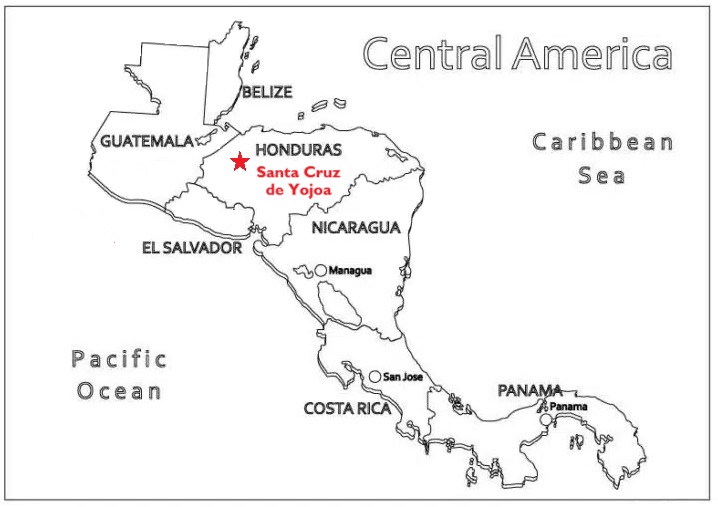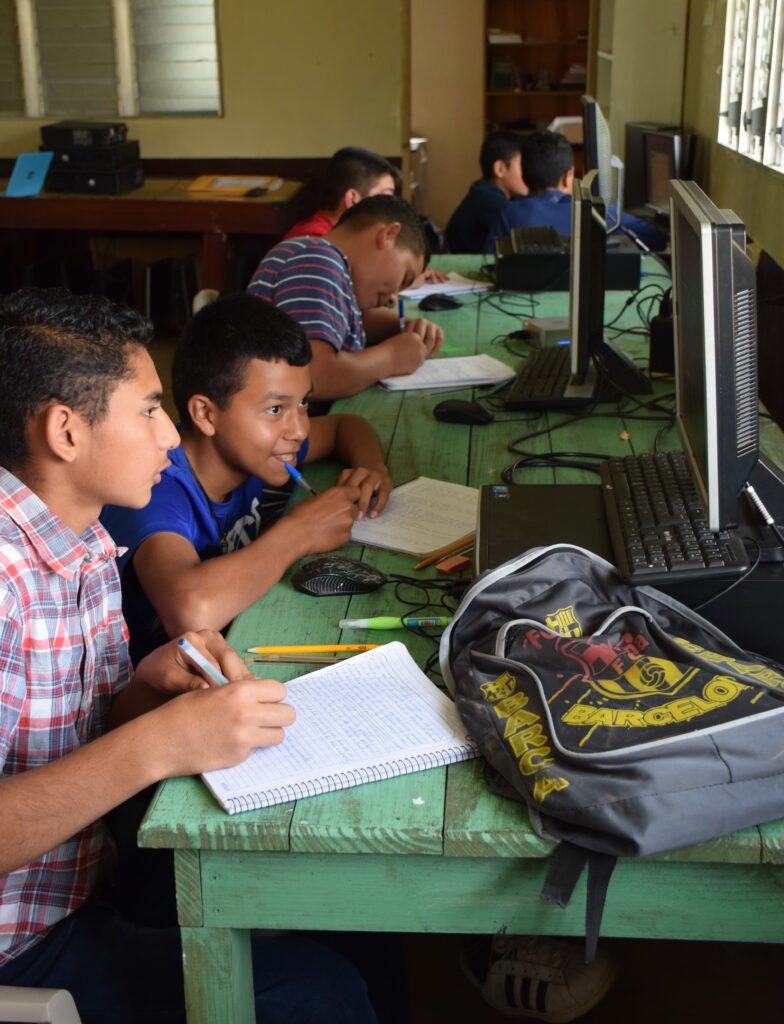| Location: | Honduras |
| Start Date: | 2009 |
| End Date: | Ongoing |
| Partners: |

Schooling in most rural Honduran villages ends at Grade 6, usually because parents cannot afford to send their children to junior high school away from home. For example, the dropout rate between Grades 6 and 7 in the Municipality of Santa Cruz de Yojoa has been as high as 96%, according to the local Superintendant of Schools
Computer Assisted Learning (CAL) is an inexpensive and effective way of providing basic education in developing countries. A digitized curriculum is installed on computers, which are used by students to learn at their own pace. After completing the curriculum, a student is eligible to take the national exams for graduation to the next grade.

Project Goals
- To remove barriers that prevent children from continuing their education beyond grade 6
- To provide quality education for grades,7 8 and 9 following the Honduran Curriculum
- To provide supplementary materials such as reading materials, reference books and a keyboarding program
- To provide access to primary education for people of any age who are illiterate or have not been able to complete primary school
Project activities:
Computer Assisted Learning Centres have been established in communities in Honduras.
The Learning Centres are staffed by technicians who assist students in accessing the curriculum and learning resources on computers.
On each computer, as well as the curriculum for grades 7,8 and 9 there is:
- A digital library of over 500 titles provides reading materials for students. This library has a deliberate peace bias, with stories that promote peace and conflict resolution without resorting to violence. Many of the stories selected for inclusion in the library have been illustrated by ACH staff. For readers who have had little access to stories, these illustrations make reading more enjoyable.
- Reference books such as a dictionary, the Encyclopedia Encarta and the Encyclopedia of Honduras, an atlas, and the Spanish version of “Where There Is No Doctor: A Village Health Care Handbook.”
- A self-instructional typing/keyboarding program to help students learn to use the keyboard efficiently.
- The curriculum for Grades 1 to 6 for illiterate people who want to learn to read.
- A GED preparation manual for people who wish to challenge the GED exams to get a high school diploma.
The ACH Philosophy is Education for All. Barriers to accessing education have been removed in these ways:
- The only condition ACH places on students who wish to enroll in the CAL program is that they have completed Grade 6.
- A commitment to the idea that education should be available to all, even those from the poorest families. The only fee associated with CAL is a $15 graduation fee at the end of each year. Any students who cannot afford the fee can do community service work in lieu of payment.
- There is no dress code. The cost of uniforms if a common barrier to school attendance in Honduras.
- Attendance is voluntary and ACH does not maintain attendance records. Students come to study without coercion on the part of the learning centre. A student missing a day or a week of study will resume at the place they left off before their absence. Similarly, students who drop out are able, when they return, to resume their studies at the point where they left off.
- There is an open admission policy. Students can enroll at any time of the year and are not restricted to a fixed start date.
The main school in Santa Cruz de Yojoa, Instituto Centro de Enseñanza Fraternidad (CEF), is registered with the Honduran Ministry of Education. This gives the school official status and the right to do certain things with the curriculum and educational delivery. It also gives the CEF the right to award graduation certificates. CAL graduates who have used the downloaded materials pay a graduation fee of HNL 300 (about C$17) to help offset some of the costs of the program.
Project Impact: Student Stories
Carol knew that her well-being, and that of her two-year-old daughter (Carol Jr.), depended on improving her education. Enrolling in a private junior high school in Santa Cruz would cost her 700 Limpera (40 CAD) a month, plus the cost of at least two uniforms, all the textbooks, and other supplies and materials. She would be in a class of more than 30 students who would all be studying the same material at the same time, so missing a class meant missing the material presented that day. She would have to start at 8:00 a.m. and stay until noon, and she couldn’t bring her daughter along. As well as being unable to pay for this, she simply couldn’t make all the required arrangements, such as child care.
Carol was 24 years old in 2012 when she enrolled in Grade 7 in the CAL program at Centro de Ensenañza Fraternidad (CPI’s main school in Santa Cruz de Yojoa). Because she had a job during the day, Carol chose the class that ran from 4 to 6 p.m. from Monday to Friday. Carol Jr. was allowed to accompany her while she studied.
On December 14, 2014 Carol graduated from Grade 9 with her daughter at her side.
Gabina is a 53-year-old woman who recently lost her husband. As a way of helping her cope with the loss, her children encouraged her to pursue her dream of education. Her first schooling was stopped by her parents when she was nine. Despite that, she enrolled in the Grade 6 Educatodos (an extension type education system to encourage village education, especially for adults) a year ago and completed the course. Even though there are no other women her age in her village who have a Grade 6 education, she is bravely pioneering in Grade 7 at Centro de Ensenañza Fraternidad. She admits that she gets teased in a friendly way by her neighbours for going back to school at her age.
A dressmaker by profession, Gabina dreams of finishing Grade 9 and then going to a dressmaking school so that she can, in turn, become a teacher of dressmaking. From her home, she walks 10 minutes down a very steep hill to catch a rapidito (small van) for the 30-minute ride to Santa Cruz. There she walks up to the school and studies for 4-1/2 hours straight. She returns home with one of the rapiditos before dark.
Karina is a 19-year-old mother of two children, aged three and two. She is married and her husband is a construction worker in their village. Her two siblings are continuing their education in other schools – University and Junior High. Obviously very gifted in school, Karina had finished Grade 8 by the time she became pregnant at age 15 (many students are only finishing Grade 6 by then). Because of the CAL program at Centro de Enseñanza Fraternidad, she now has a second chance to pursue her dream of finishing Grade 9 and then taking studies in accounting.
Karina’s parents are extremely happy for this opportunity and her mother gladly cares for the two toddlers while Karina attends school each afternoon. Even though her husband has only Grade 5, he is encouraging her to continue her studies as well.
Most of the girls her age already have children and have had to give up their hopes for an education. Karina is moving steadily through the Grade 9 course work and should be one of our first Grade 9 graduates. She hopes that her studies will, in turn, allow her to give her children a better education.
Martha is nearly 18 years old and lives at home with her parents and one sister.
Now that she is studying Grade 7, Martha has the opportunity to become the most educated member of her family. Her father, a farmer, has a Grade 3 education, and her mother, who works at home, only finished Grade 2. Centro de Enseñanza Fraternidad is offering Martha and her family the opportunity to have someone look to a future that holds other options for living and study. Martha is fortunate that her family and friends are giving her encouragement.
After Martha finishes Grade 9, she hopes to attend High School and, possibly, study accounting. After one month of classes, she has finished ¾ of the first of four textbooks. If she continues at this pace, she will finish the grade in another three months.
Luis is the oldest child in a family of four children living in a small, one-room, block house in El Ciprés. Because the family has no father present, his mother makes money for the family by cooking and selling tamales. Luis helps sell tamales or looks after the other children while his mother makes the 6-km trip to Santa Cruz to sell her wares. Two siblings are in primary school and the youngest is at home.
Luis is very grateful for the opportunity to extend his schooling beyond Grade 6 and is excited about finishing Grade 9 in Centro de Enseñanza Fraternidad. Luis has worked hard and is one of more than 15 students who are completing a Grade in less than five months.

